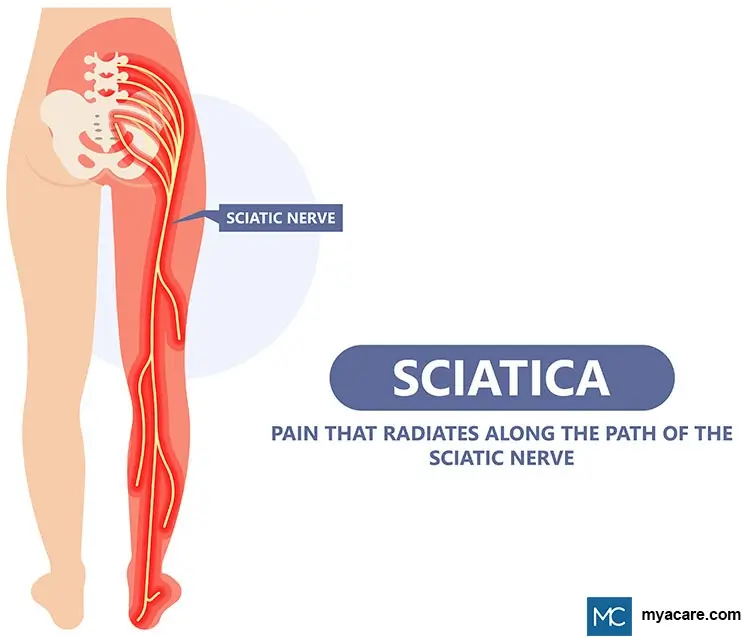Sciatica and Leg Weakness: A Worrying Combo

“Sciatica” is the term used to describe nerve pain in the lower back and buttocks that radiates down along the leg. The pain usually extends to a single side, but can sometimes affect both legs.
Sciatica results from the compression of the sciatic nerve, which is a large nerve originating in the lower spine. It can be due to disc herniation, arthritis, bone spurs, spinal canal narrowing (stenosis), trauma, compression of the piriformis muscle, or other anatomical abnormalities.
The sciatic nerve controls the leg muscles and transfers sensation. So in addition to causing pain and numbness in the leg, sciatic nerve compression can sometimes lead to leg weakness. Sciatica leg weakness can occur simultaneously with the other symptoms, however, it can sometimes follow later if the nerve compression is progressive.
Leg weakness with sciatica is a worrying sign and should prompt a doctor’s visit, especially if it’s acute or associated with impaired bowel and urinary control. The earlier the nerve compression is relieved, the better your chances of reversing the nerve damage.
What is Sciatica?
Sciatica refers to the typical nerve pain that starts in the lower back and extends to the leg. The pain usually affects one leg but can sometimes be bilateral. Sciatica is not an independent medical condition per se, but rather a feature of sciatic nerve compression or injury.

The sciatic nerve is a large nerve that originates in the lower spine, providing motor and sensory innervation to the lower back, buttocks, and legs. Its nerve roots can be injured or compressed causing sciatica due to various causes:
- Spinal disc herniation
- Spinal canal stenosis
- Arthritis
- Bone spurs
- Spinal cord tumors
- Anatomic muscle abnormalities (e.g. piriformis syndrome)
- Back trauma
- Infections (e.g. spondylodiscitis)
Nearly 40% of the population will experience sciatica at least once during their lifetime. In most cases, sciatica will resolve alone without any treatment and without any permanent nerve damage or symptoms.
Symptoms of Sciatica
The characteristics of sciatica pain vary widely from one person to another. Sciatica pain is usually described as a burning pain varying from mild to severe in intensity. The pain can occur suddenly in some people or increase gradually over days or weeks. Sciatica pain can also be associated with tingling or numbness in the affected leg.
Some of the red-flag symptoms associated with sciatica include:
- Impaired bowel or urinary control
- Leg weakness
- Numbness between the legs (saddle anesthesia)
- Problems with balance and walking
- Rapidly worsening back and leg pain
These symptoms can signify serious sciatic nerve damage and possible permanent nerve injury. If the red-flag symptoms occur acutely, you should head to the emergency department for prompt evaluation. Early diagnosis and surgery (usually within 24 hours) can reverse the nerve damage and improve neurological outcomes.
Does Sciatica Cause Leg Weakness?
Sciatica does not itself cause leg weakness. However, both sciatica and leg weakness are associated with spinal nerve damage and sometimes occur together.
As explained above, sciatica is a symptom of spinal nerve root compression or injury. The sensory symptoms of nerve compression (e.g sciatica and leg numbness) usually occur early on and improve with time, even without treatment.
In some cases, however, the nerve compression can be progressive (e.g. disc herniation or arthritis). This can lead to progressive symptoms, starting with increased sciatica pain and, with more nerve damage, leg weakness. It might start with a slight imbalance when walking at first, which can worsen over time.
In some cases, sciatica leg weakness might occur acutely. Sudden back pain and leg weakness might signify an acute process, like disc herniation with critical spinal compression.
If you have sciatica and are starting to slowly notice more leg weakness, you should see your doctor at the nearest available appointment. If the weakness has occurred suddenly or is rapidly progressing, you should go to the hospital immediately for possible emergency surgery. Early surgery can prevent permanent nerve damage from occurring and improve the outcomes.
Complications of Sciatica Leg Weakness
Even if sciatica is treated, the strength of the leg muscles might take months to be restored. In some patients, leg weakness due to nerve compression might even be permanent. In any case, loss of leg strength can lead to other complications, such as:
- Recurrence of back and leg pain: Muscle imbalance due to leg weakness can cause sciatica-like pain. The abnormal posture and gait (walking pattern) can cause improper compensatory muscle contractions in the affected leg, healthy leg, pelvis, feet, and back. They can also put abnormal pressure on ligaments and joints to try to compensate for the leg weakness and imbalance. This can lead to pain in the back, legs, and feet, similar to that experienced with sciatica.
- Gait abnormalities and imbalance: Sciatica leg weakness can affect the way you walk. Depending on the degree of nerve damage, you might just feel like one leg is slightly heavier than the other. In more severe cases, the foot might drop, and you might have difficulty walking straight or climbing the stairs.
How to Deal with Sciatica Leg Weakness?
The most detrimental factor when it comes to treating sciatica leg weakness is the rapid diagnosis and treatment. You should call your doctor as soon as you notice leg weakness with sciatica. The sooner nerve compression is diagnosed and treated, the better your chances are of walking normally again.
If you still have leg weakness after sciatica surgery, or you are not a candidate for surgery, there are several things you can do to deal with sciatica leg weakness and its associated complications.
Physical and occupational therapy plays a key role in the recovery from sciatica leg weakness.
They work on two fronts:
- Strengthening the weak leg: Your physiotherapist will help you perform targeted exercises to restore muscle strength in the weak leg. She or he will help you gain more control over the leg and gradually gain back your full strength.
- Strengthening compensatory muscles: When one leg is weak, a muscular imbalance can develop. The other side of the body will try to compensate to keep a steady posture and normal walking pattern. However, to do this, many (otherwise healthy) muscle groups, ligaments, and joints might be over-stressed, and can function abnormally, leading to pain and injury. Part of physiotherapy includes training these compensatory muscle groups to strengthen them, in addition to teaching you how you can avoid unhealthy movements that can abnormally stress your body.
A successful therapy plan to restore leg strength after spine surgery requires close cooperation between your neuro or orthopedic surgeon and your physiotherapy team. Therapy can take months and requires persistence and patience on your end, and an experienced team to guide you along. With that, you’ll hopefully be able to walk normally again in no time!
To search for the best Orthopedics Healthcare Providers in Croatia, Germany, India, Malaysia, Singapore, Spain, Thailand, Turkey, Ukraine, the UAE, UK and the USA, please use the Mya Care search engine.
Dr. Mersad is a medical doctor, author, and editor based in Germany. He has managed to publish several research papers early in his career. He is passionate about spreading medical knowledge. Thus, he spends a big portion of his time writing educational articles for everyone to learn.
Sources:
Featured Blogs



